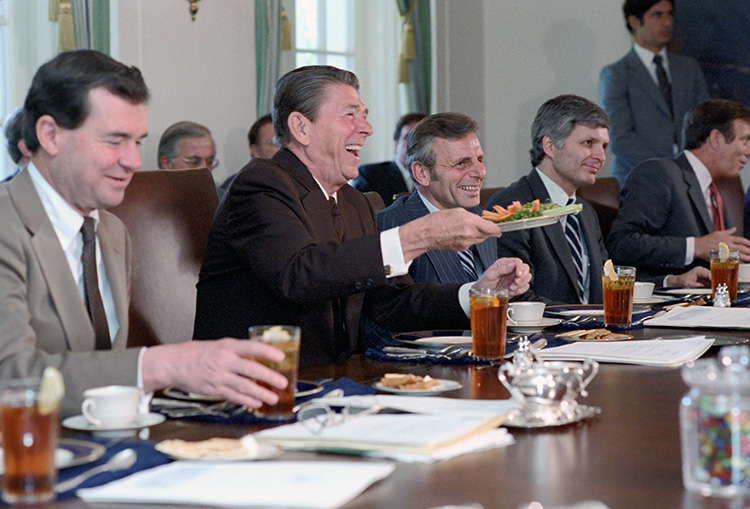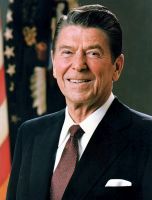| Edwin Meese | |
|---|---|
| Succeeded by | Dick Thornburgh |
| Counselor to the President | |
| In office January 20, 1981 – February 25, 1985 | |
| President | Ronald Reagan |
What is the Attorney General under Ronald Reagan crossword puzzle answer?
Oct 20, 2010 · Who was attorney general under Ronald Reagan? - Answers William French Smith (of California) - 1981 to 1985Edwin Meese III - 1985 to 1988Richard Thornburgh - 1988 - 1991In order:William French...
How many attorneys general did Reagan have?
Nyt Clues / By Rex Parker'son Attorney general under Ronald Reagan NYT Crossword Clue Answers are listed below and every time we find a new solution for this clue we add it on the answers list. If you encounter two or more answers look at the most recent one i.e the last item on the answers box. Advertisement
Who was the Secretary of State under Ronald Reagan?
Who was the Attorney General under Nixon and Reagan?

Who was Reagan's wife?
In 1938, Reagan co-starred in the film Brother Rat with actress Jane Wyman (1917–2007). They announced their engagement at the Chicago Theatre and married on January 26, 1940, at the Wee Kirk o' the Heather church in Glendale, California. Together they had two biological daughters, Maureen (1941–2001) and Christine (born prematurely, and died, June 26, 1947); and adopted a son, Michael (b. 1945). After the couple had arguments about Reagan's political ambitions, Wyman filed for divorce in 1948, citing a distraction due to her husband's Screen Actors Guild union duties; the divorce was finalized in 1949. Wyman, who was a registered Republican, also stated that their breakup stemmed from a difference in politics (Reagan was still a Democrat at the time). When Reagan became president 32 years later, he became the first divorced person to assume the nation's highest office. Reagan and Wyman continued to be friends until his death; Wyman voted for Reagan in both his runs, and on his death she said, "America has lost a great president and a great, kind, and gentle man."
Where did Ronald Reagan live?
After leaving office in 1989, the Reagans purchased a home in Bel Air, Los Angeles, in addition to the Reagan Ranch in Santa Barbara. They regularly attended Bel Air Church and occasionally made appearances on behalf of the Republican Party; Reagan delivered a well-received speech at the 1992 Republican National Convention. Previously, on November 4, 1991, the Ronald Reagan Presidential Library was dedicated and opened to the public. Five presidents and six first ladies attended the dedication ceremonies, marking the first time that five presidents were gathered in the same location. Reagan continued to speak publicly in favor of the Brady Bill; a constitutional amendment requiring a balanced budget; and the repeal of the 22nd Amendment, which prohibits anyone from serving more than two terms as president. In 1992 Reagan established the Ronald Reagan Freedom Award with the newly formed Ronald Reagan Presidential Foundation. His final public speech occurred on February 3, 1994, during a tribute to him in Washington, D.C.; his last major public appearance was at the funeral of Richard Nixon on April 27, 1994.
Why did Ronald Reagan send troops to Lebanon?
With the approval of Congress, Reagan sent forces to Lebanon in 1983 to reduce the threat of the Lebanese Civil War. The American peacekeeping forces in Beirut, a part of a multinational force during the Lebanese Civil War, were attacked on October 23, 1983. The Beirut barracks bombing killed 241 American servicemen and wounded more than 60 others by a suicide truck bomber. Reagan sent in the USS New Jersey battleship to shell Syrian positions in Lebanon. He then withdrew all the Marines from Lebanon.
What was Reagan's economic impact on the economy?
Over his two terms, the economy saw a reduction of inflation from 12.5% to 4.4% and an average real GDP annual growth of 3.6%. Reagan enacted cuts in domestic discretionary spending, cut taxes, and increased military spending, which contributed to increased federal debt overall.
When did the Patco strike?
In August 1981 , PATCO, the union of federal air traffic controllers, went on strike, violating a federal law prohibiting government unions from striking. Declaring the situation an emergency as described in the 1947 Taft–Hartley Act, Reagan stated that if the air traffic controllers "do not report for work within 48 hours, they have forfeited their jobs and will be terminated". They did not return, and on August 5, Reagan fired 11,345 striking air traffic controllers who had ignored his order and used supervisors and military controllers to handle the nation's commercial air traffic until new controllers could be hired and trained. A leading reference work on public administration concluded, "The firing of PATCO employees not only demonstrated a clear resolve by the president to take control of the bureaucracy, but it also sent a clear message to the private sector that unions no longer needed to be feared."
What high school did Ronald Reagan attend?
Reagan attended Dixon High School, where he developed interests in acting, sports, and storytelling. His first job involved working as a lifeguard at the Rock River in Lowell Park in 1927. Over six years, Reagan performed 77 rescues. He attended Eureka College. He was an indifferent student, majored in economics and sociology and graduated with a C average. He developed a reputation as a "jack of all trades", excelling in campus politics, sports, and theater. He was a member of the football team and captain of the swim team. He was elected student body president and participated in student protests against the college president.
When did Ronald Reagan start wearing hearing aids?
His decision to go public in 1983 regarding his wearing the small, audio-amplifying device boosted their sales.

Overview
Ronald Wilson Reagan was an American politician who served as the 40th president of the United States from 1981 to 1989. A member of the Republican Party, he previously served as the 33rd governor of California from 1967 to 1975 after a career as a Hollywood actor and union leader.
Reagan was born to a low-income family in Tampico, Illinois. He graduated from Eureka …
Early life
Ronald Wilson Reagan was born on February 6, 1911, in an apartment on the second floor of a commercial building in Tampico, Illinois. He was the younger son of Nelle Clyde (née Wilson) and Jack Reagan. Jack was a salesman and storyteller whose grandparents were Irish Catholic emigrants from County Tipperary, while Nelle was of English and Scottish descent. Ronald's older brot…
Entertainment career
After graduating from Eureka in 1932, Reagan took jobs in Iowa as a radio announcer at several stations. He moved to WHO radio in Des Moines as an announcer for Chicago Cubs baseball games. His specialty was creating play-by-play accounts of games using only basic descriptions that the station received by wire as the games were in progress.
Marriages and children
In 1938, Reagan co-starred in the film Brother Rat with actress Jane Wyman (1917–2007). They announced their engagement at the Chicago Theatre and married on January 26, 1940, at the Wee Kirk o' the Heather church in Glendale, California. Together they had two biological daughters, Maureen (1941–2001) and Christine (born prematurely, and died, June 26, 1947); and adopted a son,
Early political career
Reagan began as a Hollywood Democrat, and Franklin D. Roosevelt was "a true hero" to him. He moved to the right-wing in the 1950s, became a Republican in 1962, and emerged as a leading conservative spokesman in the Goldwater campaign of 1964.
In his early political career, he joined numerous political committees with a left …
Governor of California (1967–1975)
California Republicans were impressed with Reagan's political views and charisma after his "Time for Choosing" speech, and in late 1965 he announced his campaign for governor in the 1966 election. He defeated former San Francisco mayor George Christopher in the Republican primary. In Reagan's campaign, he emphasized two main themes: "to send the welfarebums back t…
1976 presidential campaign
Reagan's 1976 campaign relied on a strategy crafted by campaign manager John Searsof winning a few primaries early to damage the inevitability of Ford's likely nomination. Reagan won North Carolina, Texas, and California, but the strategy failed, as he ended up losing New Hampshire, Florida, and his native Illinois. The Texas campaign lent renewed hope to Reagan when he swept all 96 delegate…
1978: Opposition to the Briggs Initiative
In 1978, conservative state legislator John Briggs, sponsored a ballot initiative for the November 7, 1978 California state election (the Briggs Initiative) that sought to ban gays and lesbians from working in California's public schools. Officially, California Proposition 6 was a ballot initiative put to referendum on the state ballot. Early opposition was led by LGBT activists and a few progressive politicians, but to many people's surprise, Reagan moved to publicly oppose the me…
Popular Posts:
- 1. who is the attorney for the nigerian brothers involved in smollets
- 2. explanation to new employer for why attorney left firm
- 3. how to find attorney in georgia
- 4. who filled in for kaine for attorney general of pa
- 5. when did my attorney pass the bar
- 6. forms to fill when your attorney stop representing you at the bia
- 7. what time does breathitt county attorney jackson ky
- 8. animal and dog attorney what they do
- 9. if i file for divorce and my wofe doesnt get an attorney what happens
- 10. james donovan, attorney who represented a spy